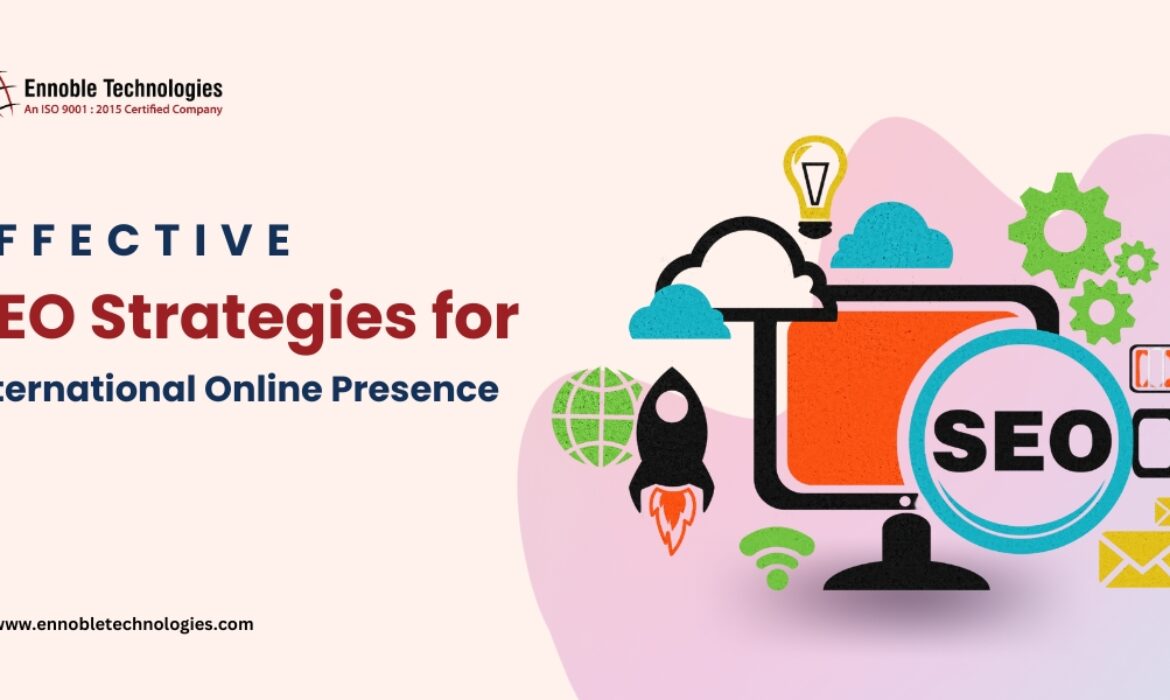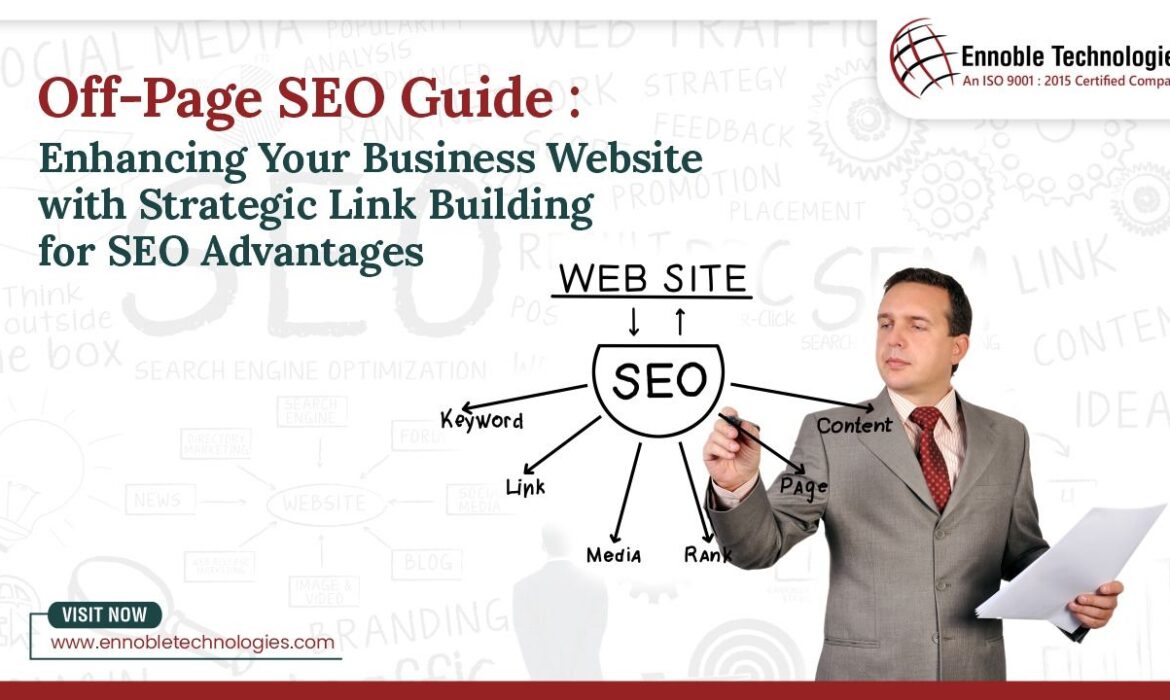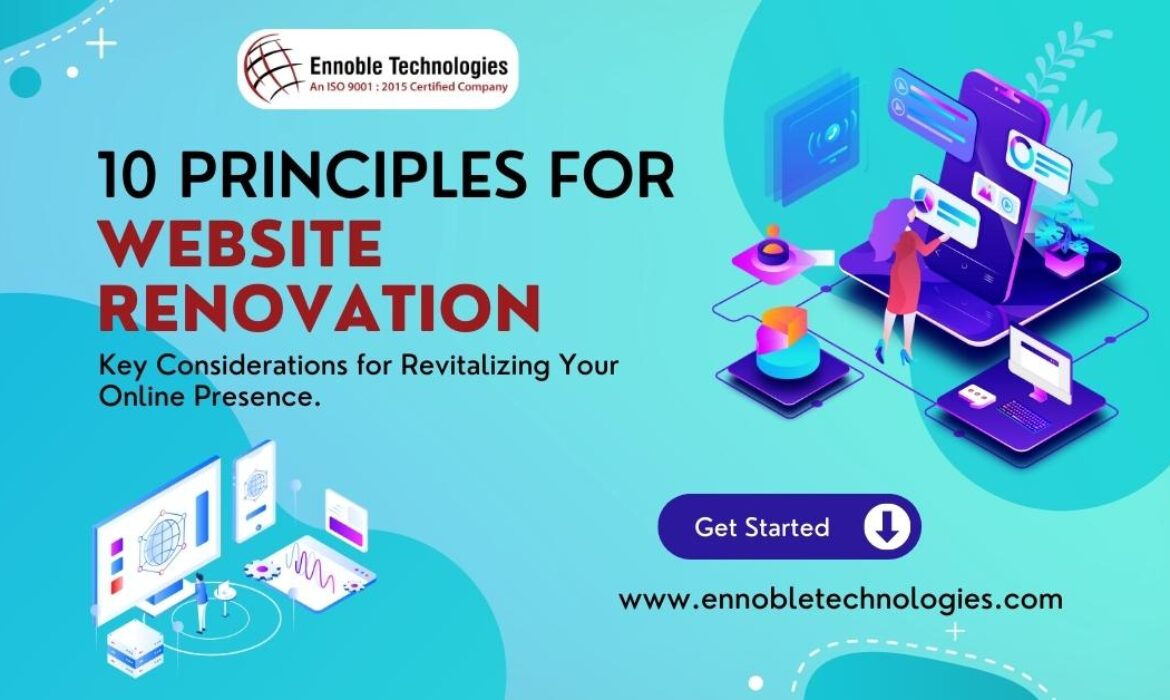Effective SEO Strategies for International Online Presence
In today’s interconnected world, businesses are no longer confined to their local markets. To thrive, companies must expand their reach to international audiences. Effective SEO strategies play a crucial role in achieving a robust online presence across different regions. At Ennoble Technologies, we specialize in providing top-notch global search engine optimization services that cater to diverse cultural and linguistic needs. In this blog, we’ll explore international SEO techniques and SEO best practices to help your business succeed on the global stage.
Understanding the Importance of International SEO
International SEO techniques are essential for businesses aiming to attract and engage customers worldwide. Unlike traditional SEO, which focuses on optimizing a website for a single country or language, global search engine optimization requires a more nuanced approach. This involves adapting your content, keywords, and overall strategy to meet the needs of different regions.
Multilingual SEO Strategies
One of the most important aspects of effective SEO strategies for international markets is the implementation of multilingual SEO strategies. This involves translating and localizing your website’s content to cater to various languages spoken by your target audience. At Ennoble Technologies, we understand the importance of providing accurate and culturally relevant translations to enhance user experience and improve search engine rankings.

Benefits of Multilingual SEO:
- Enhanced User Experience: Offering content in multiple languages makes it easier for users to understand and engage with your website.
- Increased Traffic: By catering to a broader audience, you can attract more visitors from different regions.
- Higher Conversion Rates: When users can access information in their native language, they are more likely to convert into customers.
SEO Best Practices for Different Regions
Implementing SEO best practices for different regions is crucial for the success of your international SEO efforts. Each region has its own unique search behaviors, preferences, and trends. At Ennoble Technologies, we tailor our effective SEO strategies to meet the specific needs of each market.
Key Considerations:
- Keyword Research: Conduct thorough keyword research to identify the most relevant terms for each region. This includes understanding local search intent and preferences.
- Content Localization: Adapt your content to reflect the cultural and linguistic nuances of each region. This goes beyond translation and involves customizing your messaging to resonate with local audiences.
- Technical SEO: Ensure that your website’s technical elements, such as hreflang tags, URL structures, and mobile optimization, are set up correctly for international SEO.
Leveraging SEO Analytics Tools

To measure the success of your effective SEO strategies, it’s essential to utilize SEO analytics tools. These tools provide valuable insights into your website’s performance, user behavior, and search engine rankings across different regions.
Essential SEO Analytics Tools:
- Google Analytics: Track website traffic, user demographics, and conversion rates.
- Google Search Console: Monitor your website’s presence in search results and identify any issues.
- Ahrefs: Analyze backlinks, keyword rankings, and competitor performance.
- SEMrush: Conduct comprehensive keyword research and track your SEO progress.
At Ennoble Technologies, we leverage these tools to provide our clients with data-driven insights and actionable recommendations. This enables us to continuously optimize our global search engine optimization efforts and achieve better results.
Cross-Border SEO Solutions
Expanding your online presence to international markets requires a strategic approach to cross-border SEO solutions. Ennoble Technologies offers a range of services designed to help businesses overcome the challenges of international SEO and achieve their goals.
Our Cross-Border SEO Solutions Include:
- Market Research: Conduct in-depth research to understand the target market’s needs, preferences, and competition.
- Content Strategy: Develop a content strategy that aligns with the cultural and linguistic requirements of each region.
- Link Building: Build high-quality backlinks from reputable websites in different regions to boost your website’s authority.
- Local SEO: Optimize your website for local search engines and directories to improve visibility in specific markets.
Regional SEO Strategies
Implementing regional SEO strategies is vital for businesses looking to establish a strong presence in specific geographic areas. Ennoble Technologies excels in creating customized effective SEO strategies that cater to the unique needs of different regions.
Key Elements of Regional SEO:
- Local Keywords: Identify and target keywords that are specific to the region you are targeting.
- Localized Content: Create content that addresses the interests and concerns of the local audience.
- Local Backlinks: Acquire backlinks from local websites and directories to improve your website’s authority in the region.
- Google My Business: Optimize your Google My Business profile to enhance local search visibility.
Multicultural SEO Services

Catering to a diverse audience requires a deep understanding of cultural differences and preferences. Ennoble Technologies offers multicultural SEO services that help businesses connect with customers from various cultural backgrounds.
Benefits of Multicultural SEO:
- Broader Reach: By appealing to a diverse audience, you can expand your customer base and increase your market share.
- Improved Engagement: Tailoring your content to different cultural preferences enhances user engagement and satisfaction.
- Higher ROI: Effective multicultural SEO can lead to higher conversion rates and better return on investment.
SEO Localization Expertise
SEO localization expertise is essential for businesses looking to optimize their websites for different languages and regions. At Ennoble Technologies, we have a team of experts who specialize in SEO localization to ensure that your content is culturally relevant and search engine-friendly.
Key Aspects of SEO Localization:
- Language Adaptation: Translate and adapt your content to meet the linguistic needs of your target audience.
- Cultural Relevance: Ensure that your content resonates with the cultural norms and preferences of each region.
- Technical Optimization: Implement technical SEO elements, such as hreflang tags and localized URLs, to improve search engine rankings.
Geo-Targeted SEO Solutions
For businesses targeting specific geographic areas, geo-targeted SEO solutions are crucial. Ennoble Technologies offers geo-targeted SEO solutions that help businesses improve their visibility in local search results and attract more customers from specific regions.
Key Components of Geo-Targeted SEO:
- Local Keywords: Identify and target keywords that are relevant to the specific geographic area.
- Local Content: Create content that addresses the needs and interests of the local audience.
- Local Listings: Optimize your website for local directories and listings to enhance local search visibility.
- Google Maps Optimization: Optimize your Google Maps listing to improve local search rankings.
Conclusion
In conclusion, implementing effective SEO strategies is essential for businesses looking to establish a strong international online presence. At Ennoble Technologies, we offer a comprehensive range of global search engine optimization services, including multilingual SEO strategies, cross-border SEO solutions, and geo-targeted SEO solutions. By leveraging our expertise and utilizing advanced SEO analytics tools, we help businesses achieve their international SEO goals and connect with customers worldwide. Whether you are looking to expand your reach to new markets or enhance your visibility in specific regions, Ennoble Technologies has the knowledge and experience to deliver results. Contact us today to learn more about our multicultural SEO services and how we can help your business succeed on the global stage.
Read more: Unlocking Google AdWords PPC Strategies for Success
Off-Page SEO Guide: Enhancing Your Business Website with Strategic Link Building for SEO Advantages
Introduction
In the world of digital marketing, Off-Page SEO plays a critical role in enhancing the visibility and ranking of websites on search engine results pages (SERPs). It focuses on optimizing factors outside the website itself, such as link building and online reputation management. Let’s delve deeper into the realm of Off-Page SEO and discover how strategic link building and other techniques can significantly impact your business’s online presence.
Understanding Off-Page SEO : A Beginner’s Guide
What is Off-Page SEO?
Off-Page SEO refers to optimization efforts that occur outside the boundaries of a website. It involves activities aimed at improving the website’s authority, relevance, and trustworthiness in the eyes of search engines. These efforts are crucial because search engines like Google consider external factors to determine a website’s credibility and rank it accordingly on SERPs.
One of the primary goals of Off-Page SEO is to acquire high-quality backlinks from reputable websites. These backlinks act as votes of confidence for your site, signaling to search engines that other sites trust your content enough to link back to it. As a result, your website’s authority and visibility increase, leading to higher rankings and organic traffic.
Importance of Off-Page SEO:
Off-Page SEO plays a pivotal role in enhancing your website’s visibility and authority on search engines. It focuses on external factors like backlinks, social signals, and brand mentions that contribute to your site’s overall reputation. By implementing effective Off-Page SEO strategies, you can improve your search engine rankings, attract organic traffic, and boost brand credibility.
Difference Between On-Page and Off-Page SEO:
On-Page SEO involves optimizing individual web pages for search engines by optimizing content, meta tags, and internal linking. In contrast, Off-Page SEO focuses on external factors such as backlinks, social media engagement, and online reputation management. While On-Page SEO is about optimizing the structure and content of your website, Off-Page SEO aims to increase your site’s authority and trustworthiness through external signals.
Types of Off-Page SEO Techniques:
a. Link Building: Acquiring quality backlinks from authoritative websites is a fundamental Off-Page SEO technique.
b. Social Media Engagement: Actively engaging with your audience on social media platforms can boost brand visibility and generate social signals.
c. Content Marketing: Creating valuable and shareable content like infographics, videos, and blog posts can attract natural backlinks.
d. Influencer Outreach: Collaborating with influencers can expand your reach and attract relevant traffic to your site.
e. Local SEO: Optimizing your online presence for local searches through local directories and Google My Business is crucial for local businesses.
Importance of Backlinks in SEO: Basics and Benefits
Backlinks are incoming hyperlinks from one webpage to another. They are a fundamental aspect of Off-Page SEO and hold significant weight in search engine algorithms. Search engines view backlinks as endorsements or votes of confidence for a website’s content. The more high-quality backlinks a site has, the more authority and credibility it gains in the eyes of search engines.
There are two main types of backlinks: Dofollow and Nofollow. Dofollow links pass link equity and contribute to a website’s SEO rankings. On the other hand, Nofollow links do not pass link equity but can still drive traffic and improve brand visibility.
Quality backlinks offer several benefits for SEO, including improved search engine rankings, increased organic traffic, enhanced online visibility, and greater trust and authority. However, it’s essential to focus on acquiring natural and relevant backlinks from authoritative sources to maximize these benefits.
Anchor Text Optimization: Beginner to Advanced Techniques
Anchor text plays a crucial role in Off-Page SEO, as it provides context and relevance to the linked content. Optimizing anchor text involves using relevant keywords or phrases that accurately describe the linked page’s content. This optimization helps search engines understand the content’s topic and improves the linked page’s ranking for those keywords.
Beginners can start by using descriptive anchor text that clearly indicates what the linked page is about. As you advance, consider using variations of anchor text, including exact match, partial match, branded, and generic anchor text. Diversifying anchor text types and incorporating long-tail keywords can enhance link relevance and improve SEO performance.
Directory Submissions Demystified: Step-by-Step Guide
Directory submissions are a common Off-Page SEO technique used to improve website visibility and generate backlinks. Directories are online platforms that categorize and list websites based on their niche or industry. Submitting your website to relevant directories can enhance its online presence and attract potential visitors and customers.
To submit your website to directories effectively, follow these steps:
- Research and identify reputable directories in your industry.
- Ensure your website meets the directory’s submission guidelines.
- Create a compelling and informative listing for your website.
- Submit your website to the selected directories, providing accurate and up-to-date information.
- Regularly monitor and update your directory listings to maintain accuracy and relevance.
By following this step-by-step guide, you can leverage directory submissions to boost your website’s visibility and attract valuable traffic.
Unlocking Off-Page SEO: Mastering Strategic Link Building for Business Growth

In today’s competitive digital landscape, Off-Page SEO plays a pivotal role in enhancing your website’s visibility and driving organic traffic. As businesses strive to optimize their online presence, understanding the nuances of Off-Page SEO becomes imperative. In this comprehensive guide, we delve into key Off-Page SEO strategies, including guest blogging, social bookmarking, harnessing social signals, influencer marketing, and PR outreach.
Guest Blogging Essentials: How to Get Started
Guest blogging is a powerful Off-Page SEO technique that not only helps in acquiring backlinks but also establishes your authority in your industry. By contributing valuable content to reputable websites, you can reach a wider audience and drive targeted traffic to your site. Here’s how to kickstart your guest blogging journey.
Introduction to Guest Blogging and its Benefits for SEO
Guest blogging involves writing and publishing content on other websites as a guest contributor. It offers several benefits for SEO, including building backlinks, increasing brand exposure, and improving search engine rankings.
How to Find Guest Blogging Opportunities in Your Niche
Start by researching websites in your niche that accept guest posts. Use search engines and social media platforms to identify potential opportunities. Look for websites with a strong domain authority and engaged audience.
Tips for Writing a Successful Guest Blog Post and Outreach Strategies
When crafting your guest blog post, focus on providing valuable, informative content that resonates with the target audience of the hosting site. Personalize your outreach emails to site owners, highlighting the value you can offer through your guest post.
Social Bookmarking Strategies: Tips for Success
Social bookmarking is another effective Off-Page SEO strategy that involves bookmarking your website or content on social bookmarking platforms. Here’s how to leverage social bookmarking for SEO benefits.
Explanation of Social Bookmarking and its Relevance in SEO
Social bookmarking platforms allow users to save, organize, and share web pages. These platforms have high domain authority, making them ideal for creating backlinks and improving website visibility.
Benefits of Social Bookmarking for Improving Website Visibility
Social bookmarking helps in generating backlinks, driving referral traffic, and increasing online visibility. It also enhances your website’s authority and credibility in the eyes of search engines.
Tips and Strategies for Effective Social Bookmarking
Choose relevant and popular social bookmarking platforms to share your content. Optimize your bookmarks with catchy titles, descriptions, and relevant keywords. Engage with other users’ bookmarks and participate in relevant communities to maximize your reach.
Harnessing Social Signals for SEO: Beginner’s Overview

Social signals refer to the metrics related to social media engagement, such as likes, shares, comments, and social media mentions. These signals can influence search engine rankings and online visibility. Here’s how to harness social signals for SEO success:
Understanding Social Signals and their Impact on Search Rankings
Social signals indicate the popularity and relevance of your content on social media platforms. Search engines consider social signals as a measure of user engagement and content quality, which can impact search rankings.
Importance of Social Signals in SEO and How They are Measured
Social signals contribute to building brand authority, driving traffic, and improving search engine visibility. Metrics like social shares, likes, comments, and follower growth are used to measure social signals’ effectiveness.
Strategies to Increase Social Signals and Monitor their Effectiveness
Create shareable and engaging content that encourages social media interactions. Use social media analytics tools to track social signals and monitor the performance of your social media campaigns. Encourage audience participation and interaction to boost social signals.
Influencer Marketing for Link Building: Getting Started Guide
Influencer marketing involves collaborating with influential individuals in your industry to promote your brand, products, or services. This strategy not only helps in building backlinks but also expands your reach and credibility. Here’s how to leverage influencer marketing for link building.
Introduction to Influencer Marketing and its Benefits for SEO
Influencer marketing allows you to tap into the existing audience of influencers and leverage their authority and credibility to promote your brand. It can result in quality backlinks, increased brand awareness, and improved search engine rankings.
How to Find and Engage with Influencers in Your Industry
Identify relevant influencers in your niche using social media platforms, influencer marketing tools, and industry directories. Build relationships with influencers by engaging with their content, offering value, and showcasing mutual benefits.
Collaborating with Influencers for Link Building and Measuring ROI
Collaborate with influencers on content creation, guest blogging, product reviews, or sponsored campaigns that include backlinks to your website. Track the performance of influencer collaborations using metrics like referral traffic, backlinks, conversions, and ROI.
PR Outreach and Press Releases: Best Practices
PR outreach and press releases are traditional yet effective Off-Page SEO tactics for gaining media coverage, building brand authority, and acquiring backlinks from reputable sources. Here’s how to execute PR outreach and press releases strategically:
Importance of PR Outreach in SEO
PR outreach helps in creating brand buzz, securing media coverage, and earning high-quality backlinks from authoritative sources. It enhances brand visibility, credibility, and trust among target audiences and search engines.
How to Write an Effective Press Release for Maximum Impact
Craft compelling press releases that are newsworthy, timely, and relevant to your target audience. Include relevant keywords, quotes, multimedia elements, and a strong call-to-action (CTA). Distribute press releases to reputable media outlets, journalists, and industry influencers.
Strategies for PR Outreach and Leveraging Press Releases for Link Building
Build relationships with journalists, bloggers, and media professionals through personalized outreach. Offer exclusive content, insights, or interviews to attract media attention. Monitor press coverage, track backlinks, and measure the impact of PR campaigns on SEO performance.
By implementing these Off-Page SEO strategies effectively, businesses can enhance their online visibility, improve search engine rankings, and drive organic traffic to their websites. Incorporate these actionable tips and best practices into your digital marketing efforts to optimize Off-Page SEO and achieve long-term success in the digital landscape.
Forum Engagement for SEO: Tips and Tricks
Engaging in forums can significantly boost your off-page SEO efforts. By actively participating in relevant forums within your industry, you can enhance your brand visibility and establish authority in your niche.
When choosing forums to engage with, prioritize those that are highly relevant to your business. Look for active communities where discussions align with your expertise and target audience.
To make the most out of forum engagement, focus on providing valuable insights and solutions to discussions. Avoid spammy or promotional posts, as these can harm your reputation and credibility.
Building rapport with other forum members is key. Respond to queries, share your knowledge, and engage in meaningful conversations to showcase your expertise.
By consistently contributing valuable content and engaging with others, you can gradually build a positive reputation and attract organic traffic to your website through forum links.
Creating Link-Worthy Infographics: Basics for Beginners

Infographics are powerful tools for link building and content marketing. They combine visual appeal with informational content, making them highly shareable and link-worthy.
When designing infographics, focus on topics that resonate with your target audience and address common pain points or interests. Use compelling visuals, statistics, and key takeaways to make your infographic informative and engaging.
To attract backlinks, consider outreach strategies such as sharing your infographic with industry influencers, bloggers, and websites that publish relevant content. Provide them with a brief summary and encourage them to link back to your infographic when they use it in their content.
Promote your infographics across social media platforms, email newsletters, and other channels to maximize exposure. Encourage sharing and make it easy for others to embed your infographic on their websites.
By creating link-worthy infographics and promoting them effectively, you can earn valuable backlinks, improve your website’s online visibility, and enhance your SEO efforts.
Building Natural Links through Relationships: Strategies for Success
Building strong relationships is essential for acquiring natural backlinks and enhancing SEO performance. Start by identifying key influencers, bloggers, and industry experts within your niche.
Networking events, conferences, and online communities are great places to connect with potential link partners. Engage with them genuinely, offer value, and show interest in their work to build meaningful relationships.
Collaborate on content projects, guest blog posts, or joint ventures to create mutually beneficial opportunities for link building. By leveraging each other’s audiences and expertise, you can attract natural backlinks and improve your search engine rankings.
Maintain regular communication with your link partners and continue to nurture relationships over time. Monitor link placements, track performance metrics, and adapt your strategies based on data insights to optimize your off-page SEO efforts.
Competitor Backlink Analysis: Tools and Insights
Analyzing your competitors’ backlinks can provide valuable insights for enhancing your own link building strategy. Start by identifying your main competitors and using SEO tools to analyze their backlink profiles.
Look for patterns in their backlink sources, anchor text usage, and link quality. Identify high-authority websites that link to your competitors, and explore opportunities to acquire similar backlinks for your site.
Utilize backlink analysis tools to assess the authority and relevance of competitor backlinks. Focus on acquiring backlinks from reputable websites within your industry to improve your own search engine rankings.
Extract insights from competitor backlinks to identify gaps and opportunities in your link building strategy. Tailor your outreach efforts, content creation, and promotional tactics based on competitive analysis to stay ahead in SEO.
Essential Off-Page SEO Tools: Must-Have Resources
Using the right tools is crucial for optimizing your off-page SEO efforts. Top off-page SEO tools offer a range of features for link building, keyword research, backlink analysis, and performance tracking.
Invest in tools that provide comprehensive link building insights, such as backlink quality assessment, competitor analysis, and link tracking capabilities. These tools help you identify link opportunities, monitor progress, and optimize your off-page SEO strategy.
Keyword research tools are essential for identifying relevant keywords, analyzing search volume, and uncovering SEO opportunities. Use backlink analysis tools to assess your backlink profile, track new links, and monitor link quality over time.
Reporting and analytics tools are critical for measuring off-page SEO success. Track key performance indicators (KPIs) like backlink growth, referral traffic, social signals, and conversion rates to evaluate the effectiveness of your SEO efforts.
Measuring Off-Page SEO Success: Key Metrics to Track
To measure the success of your off-page SEO efforts, track key metrics that reflect link building, social signals, and online visibility. These metrics provide valuable insights into your SEO performance and areas for improvement.
Key performance indicators (KPIs) for off-page SEO include:
- Backlink Quality: Monitor the quality and relevance of your backlinks, focusing on authoritative and diverse link sources.
- Social Signals: Track engagement metrics like likes, shares, comments, and mentions on social media platforms to gauge audience interaction.
- Referral Traffic: Analyze traffic from external sources to measure the impact of link building efforts on website visits.
- Conversion Rates: Measure the percentage of visitors who complete desired actions, such as signing up for newsletters or making purchases.
Using data-driven insights from these metrics, optimize your off-page SEO strategies for improved search engine rankings and online visibility.
On a final note:
Mastering off-page SEO is essential for enhancing your website’s rankings, driving organic traffic, and improving online visibility. By implementing strategic link building, leveraging digital marketing techniques, and monitoring key metrics, you can achieve SEO advantages and business growth. Follow the strategies discussed in the guide to boost your off-page SEO results and achieve online visibility optimization.
Read more: https://ennoblegrp.com/seo/mobile-optimization-for-on-page-seo/
E-E-A-T Unveiled: Elevating Your Online Presence with Expertise, Authoritativeness, and Trustworthiness
Understanding E-A-T
What is E-A-T?
E-A-T stands for Expertise, Authoritativeness, and Trustworthiness. Expertise refers to the depth of knowledge and skill in a particular subject. Authoritativeness pertains to being recognized as a credible and influential source within a specific industry or field. Trustworthiness involves establishing reliability, transparency, and integrity to gain the trust of users.
Search engines prioritize websites that exhibit high levels of E-A-T as they aim to deliver the most relevant and trustworthy results to users. Websites with strong E-A-T are perceived as reliable sources of information, which leads to higher search engine rankings and increased visibility.
Websites like Mayo Clinic (Expertise), Harvard Business Review (Authoritativeness), and Consumer Reports (Trustworthiness) are excellent examples of entities that excel in one or more aspects of E-A-T. These websites consistently produce high-quality, credible content that resonates with their target audience, thus establishing themselves as authoritative sources in their respective fields.
The Role of E-A-T in SEO
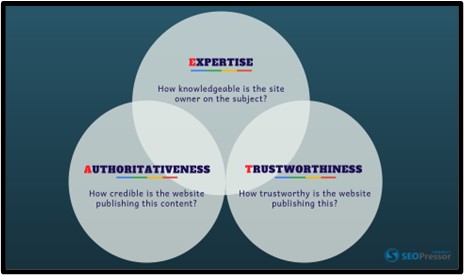
Search engines assess E-A-T through various factors, including content quality, backlink profile, user experience, and website reputation. Algorithms analyze signals such as expertise demonstrated by content creators, endorsements from authoritative sources, and user feedback to gauge the trustworthiness and credibility of a website.
Google’s E-A-T update, which rolled out in 2018, placed greater emphasis on the quality and expertise of content, particularly in the health and finance niches. Websites that failed to demonstrate expertise, authoritativeness, and trustworthiness saw a decline in their search visibility, highlighting the importance of aligning with E-A-T guidelines.
Websites that prioritize E-A-T principles often experience improved search rankings and visibility. By consistently delivering valuable, authoritative content and fostering trust with users, these websites attract more organic traffic and earn higher rankings in search engine results pages (SERPs).
—————————————————————————————————————————————————————–
Demystifying E-E-A-T: A Timeline and Deep Dive
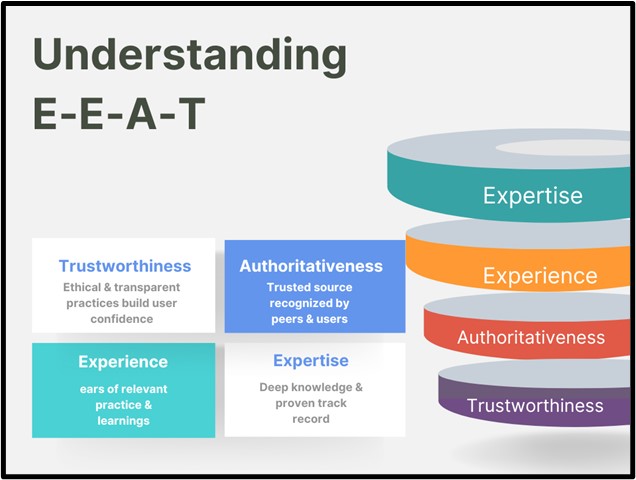
E-E-A-T, short for Expertise, Experience, Authoritativeness, and Trustworthiness, has become a crucial factor in Google’s search algorithm, impacting website rankings and user trust. Let’s delve into its history, evolution, and key aspects through a comprehensive timeline:
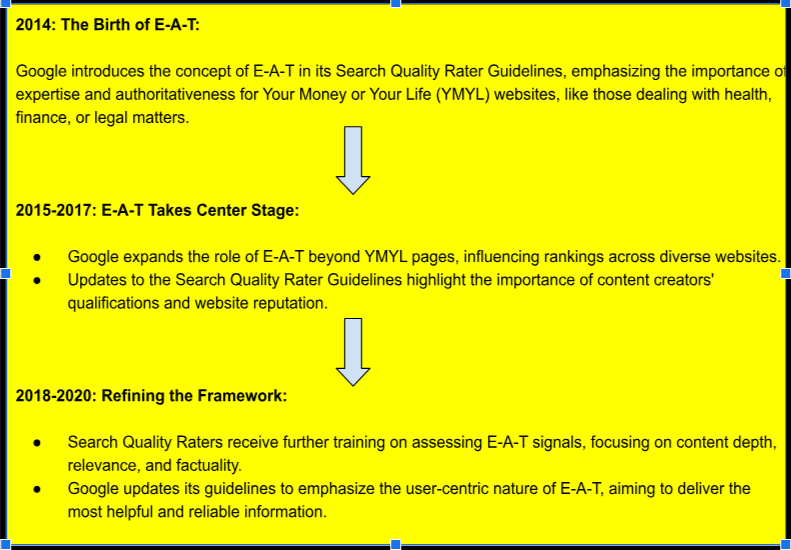
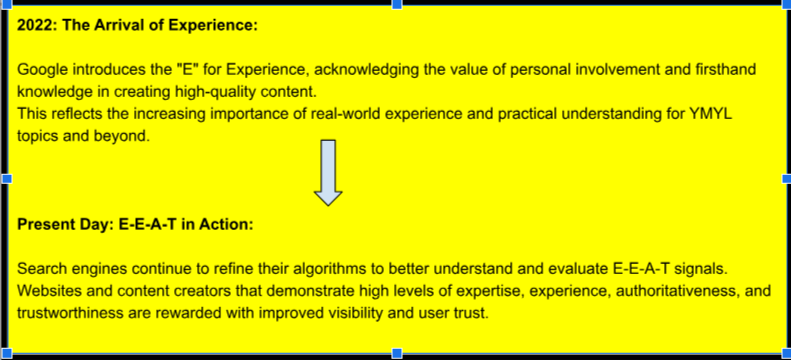
Key Points to Remember:
- E-E-A-T is an ongoing effort, not a one-time achievement.
- There are no shortcuts for building E-E-A-T; consistent focus on quality and user-centricity is paramount.
- E-E-A-T applies to all websites, regardless of industry or niche.
- Google’s search algorithm evolves continuously, so staying updated on best practices is crucial.
- Beyond the Timeline.
FAQs
Q: Who drives E-E-A-T?
A: Google Search Quality Raters, a global team of human experts, evaluate websites and content based on E-E-A-T principles.
Q: How does E-E-A-T impact search results?
A: Websites with high E-E-A-T tend to rank higher in relevant searches, as Google prioritizes content deemed trustworthy and helpful.
Q: What are the benefits of high E-E-A-T?
A: Increased website traffic, improved user engagement, stronger brand reputation, and potentially higher conversion rates.
By understanding the origins, evolution, and key aspects of E-E-A-T, you can develop a strategic approach to create content and build a website that resonates with both users and search engines. Remember, the journey towards high E-E-A-T is a continuous pursuit of excellence, focused on delivering valuable information and building genuine trust with your audience.
Exploring the Four Pillars of EEAT:
- Expertise
- Experience
- Authoritativeness
- Trustworthiness
Expertise: Establishing Content Authority
Showcasing Expertise Through Content
- Conduct thorough research on relevant topics.
- Provide original insights and analysis.
- Offer comprehensive coverage of content.
In-depth research ensures the accuracy and credibility of your content, while original insights and comprehensive coverage demonstrate your expertise and thought leadership in your field.
- Identify trending topics within your niche.
- Address common pain points or questions from your target audience.
- Leverage keyword research to uncover topics with high search demand.
Demonstrating Expertise: A Table of Strategies
| Aspect of Expertise | Strategies | Examples |
| Qualifications | * Highlight relevant educational degrees, certifications, or professional licenses. * Mention awards or recognitions received in your field. * Showcase membership in professional organizations or associations. | * “Dr. Sarah Jones, a board-certified dermatologist with 15 years of experience…” * “Winner of the 2023 ‘Best Technology Blog’ award.” * “Member of the American Marketing Association.” |
| Experience | * Describe your professional background and relevant past projects. * Share case studies or success stories demonstrating expertise in action. * Quantify your experience with years, numbers, or specific achievements. | * “Led a team of engineers to develop a new software application used by over 1 million people.” * “Increased website traffic by 300% through SEO optimization strategies.” * “10+ years of experience in writing and editing technical content.” |
| Achievements | * Share published articles, research papers, or books you’ve authored. * Mention speaking engagements or presentations you’ve delivered. * Highlight notable contributions you’ve made to your field. | * “Author of the best-selling book ‘The Art of Persuasive Writing’.” * “Featured speaker at the International Marketing Conference.” * “Developed a new training program for customer service representatives that resulted in a 20% increase in customer satisfaction.” |
| Content & Communication | * Craft high-quality content that is accurate, informative, and well-researched. * Use clear, concise language and avoid jargon when possible. * Respond to comments and questions thoughtfully and professionally. | * Cite credible sources to support your claims. * Use visuals, data, and examples to enhance understanding. * Engage in respectful discussions and offer alternative perspectives. |
| Thought Leadership | * Share your expertise through blog posts, articles, or social media. * Offer insights and opinions on current trends and issues in your field. * Participate in online communities and forums related to your area of expertise. | * Write guest posts for industry publications. * Start a podcast or YouTube channel to share your knowledge. * Host webinars or online workshops on relevant topics. |
Experts in Digital Marketing: A Diverse Landscape
| Field | Individuals | Organizations |
| SEO | Rand Fishkin (Moz), Bill Slawski, Aleyda Solis, Barry Schwartz, Marie Haynes | Moz, Search Engine Land, SEMrush, Backlinko, Ahrefs |
| Content Marketing | Neil Patel (Neil Patel Digital), Ann Handley (MarketingProfs), Joe Pulizzi, Andy Crestodina, Jay Baer (Convince & Convert) | Content Marketing Institute, Copyblogger, BuzzSumo, HubSpot Academy, Content Marketing Mastery |
| Social Media Marketing | Kim Garst, Ian Cleary (RazorSocial), Mari Smith, Amy Porterfield, Gary Vaynerchuk | Social Media Examiner, Hootsuite, Sprout Social, Buffer, Socialbakers |
| Paid Advertising | Frederick Vallaeys, Larry Kim (MobileMonkey), Brad Geddes, Perry Marshall, Charles Ngo | WordStream, PPC Hero, Unbounce, The SEM Agency, KlientBoost |
| Analytics & Data-Driven Marketing | Avinash Kaushik, Simon Kemp, Greg McKeown, Cindy Krum, RJ Metrics | Google Analytics Academy, Mixpanel, Looker, Tableau, Amplitude |
Experience
While expertise, authoritativeness, and trustworthiness are well-established pillars of E-E-A-T, the recent addition of “experience” brings a fresh perspective to this framework. Let’s delve into what experience signifies and how it impacts your online presence:
Experience: More Than Just Years
Experience goes beyond mere years in the field. It encompasses:
- Firsthand knowledge: Having actively engaged in the subject matter, not just studying it theoretically.
- Practical understanding: Applying your knowledge to solve real-world problems and challenges.
- Proven track record: Demonstrating successes and achievements through case studies, testimonials, or portfolio showcases.
- Direct interactions: Engaging with the audience, understanding their needs, and providing relevant solutions.
Why Experience Matters:
- Enhanced credibility: Personal experience adds depth and authenticity to your content, making it more relatable and believable.
- Sharpened insights: Real-world experience helps you identify pain points, anticipate user needs, and offer valuable solutions.
- Improved content quality: Practical knowledge translates into content that is grounded, informative, and actionable.
- Stronger audience connection: Sharing your experiences fosters empathy and builds trust with your audience.
—————————————————————————————————————————————————————–
Building Your E: My Evolution in Digital Marketing: From Scratch to Heights (A 10+ Year Journey)
My journey in digital marketing began over a decade ago, fueled by a fascination with the power of the internet to connect and influence. Starting with basic HTML and SEO knowledge gleaned from online tutorials, I embarked on a self-taught path that would lead me through the trenches of both white hat and black hat practices, ultimately shaping the ethical and data-driven marketer I am today.
Early Days: Experimentation and Exploration:
My first foray was building websites for friends and local businesses, learning the ropes of design, development, and basic SEO.
Curiosity led me to explore the “dark side” of SEO – keyword stuffing, link farms, and other black hat techniques. While initially successful, I quickly realized the ethical and long-term sustainability issues involved.
Learning and Evolving:
This experience sparked a deep dive into ethical and sustainable digital marketing practices. I devoured books, blogs, and online courses, soaking up knowledge from industry authorities.
Joining online communities and forums connected me with other passionate marketers, fostering valuable learning and collaboration.
Putting Theory into Practice:
Equipped with newfound knowledge, I started freelancing, offering SEO, content marketing, and social media management services.
Working with diverse clients across industries honed my skills and adaptability, allowing me to tackle unique challenges and achieve tangible results.
Climbing the Ladder:
Joining a small digital marketing agency provided invaluable experience in team dynamics, client management, and campaign strategy development.
Contributing to successful campaigns for major brands solidified my understanding of data-driven decision-making and the importance of measuring impact.
Reaching New Heights:
Today, I find myself at the forefront of the digital marketing landscape, leading a team of talented individuals.
We focus on crafting data-driven, user-centric strategies that deliver results while adhering to ethical and sustainable practices.
My journey has been a continuous learning process, fueled by a passion for innovation and a commitment to building trust with both users and clients.
—————————————————————————————————————————————————————–
Authoritativeness: Becoming a Trusted Source
What Makes a Source Authoritative?
In the digital age, discerning reliable information from noise requires understanding what makes a source authoritative. This goes beyond just a name or label; it’s a combination of factors that build trust and credibility. Here are the key elements:
Key Elements of an Authoritative Source:
Recognition: | Recognition | Score | —|—
- Established reputation | 8/10 |
- Affiliation with prestigious institutions | 7/10 |
- Awards and accolades | 6/10 |
- Industry endorsements | 5/10 |
Recognition reflects the source’s standing within its field. A well-established research institute naturally carries more weight than a personal blog. Awards and affiliations further solidify recognition, but they’re not the sole indicators.
Reputation: | Reputation | Score | —|—
- Transparency in methodology and data sources | 8/10 |
- Accuracy and factuality of information | 8/10 |
- Lack of bias or conflicts of interest | 7/10 |
- Positive feedback from experts and users | 6/10 |
Reputation hinges on the source’s commitment to truth and objectivity. Transparency allows users to evaluate the information’s foundation, while factual accuracy is paramount. Minimizing bias and garnering positive feedback from trusted individuals further strengthens reputation.
Influence: | Influence | Score | —|—
- Reach and engagement with target audience | 7/10 |
- Impact on shaping opinions and discussions | 6/10 |
- Frequency of citations by other reputable sources | 5/10 |
- Trusted by key decision-makers and experts | 5/10 |
Influence reflects the source’s ability to shape the conversation and reach the intended audience. High engagement and reach indicate a substantial following, while citation frequency shows how other experts value the source’s information. Influence also extends to shaping opinions and being trusted by decision-makers.
Establishing Authoritative Backlinks
Backlinks from reputable websites serve as endorsements of your content and contribute to your website’s authority and credibility.
- Create valuable, link-worthy content.
- Outreach to relevant websites or influencers in your niche.
- Participate in industry events or collaborations.
Avoid manipulative link-building practices such as buying links or participating in link schemes, as they can result in penalties from search engines and damage your website’s reputation.
Optimizing Website Structure and Navigation
- Use clear and descriptive headings.
- Implement a hierarchical site structure.
- Include breadcrumbs for easy navigation.
Clear navigation menus and breadcrumbs help users navigate your website easily, while internal linking improves crawlability and helps search engines discover and index your content. Optimizing meta tags, headings, and URL structures with relevant keywords can improve your website’s visibility in search results and attract more organic traffic.
Consistency Across Platforms
Consistency in branding and messaging helps reinforce your brand identity and build trust with your audience across different platforms.
Ensure that your social media profiles, business listings, and other online assets reflect your brand’s identity and values consistently.
Regularly monitor online reviews and feedback from customers, and respond promptly to address any concerns or issues. Positive reviews and testimonials can enhance your reputation and credibility.
Trustworthiness: Building Customer Confidence
Building Trust: Key Factors and Visual Representation
Trust is the cornerstone of any successful interaction, be it personal or online. In the digital world, where information overload and potential deception lurk around every corner, building trust is crucial for websites, brands, and individuals. Here are the key factors that contribute to trustworthiness, visualized in a bar graph:
Key Factors Building Trust:
Transparency: | Transparency | Score | —|—
- Clear communication of policies and practices | 8/10 |
- Easy access to information about the team or organization | 7/10 |
- Honest disclosure of potential biases or limitations | 6/10 |
- Willingness to engage in open communication and feedback | 5/10 |
Transparency fosters trust by allowing users to understand who they’re interacting with, how their data is used, and what to expect. Clear communication, open access to information, and a willingness to address concerns are key components.
Ethics: | Ethics | Score | —|—
- Commitment to ethical data collection and usage practices | 8/10 |
- Respect for user privacy and security | 7/10 |
- Avoidance of misleading or deceptive information or practices | 6/10 |
- Alignment with ethical principles relevant to the field | 5/10 |
Ethical behavior builds trust by demonstrating respect for users and their data. Responsible data handling, honest information, and adherence to relevant ethical guidelines are essential.
Data Privacy: | Data Privacy | Score | —|—
- Strong data security measures to protect user information | 8/10 |
- Clear and understandable data privacy policies | 7/10 |
- User control over data collection and usage practices | 6/10 |
- Respect for user preferences regarding data sharing and marketing | 5/10 |
Data privacy plays a crucial role in building trust. Robust security measures, clear policies, user control over data, and respecting preferences show commitment to protecting user information.
Competence: | Competence | Score | —|—
- Demonstrated expertise and knowledge in the relevant field | 8/10 |
- Ability to deliver on promises and commitments | 7/10 |
- Consistent delivery of high-quality content or services | 6/10 |
- Willingness to learn and adapt to changing needs and challenges | 5/10 |
Competence builds trust by demonstrating the ability to provide value. Expertise, reliability, consistent quality, and a commitment to learning show that users can rely on the individual or organization.
Authenticity: | Authenticity | Score | —|—
- Genuine and relatable presentation of oneself or organization | 8/10 |
- Openness and vulnerability in communication | 7/10 |
- Consistency between online and offline personas or values | 6/10 |
- Active engagement in building genuine connections with users | 5/10 |
Authenticity fosters trust by creating a sense of connection and genuine interaction. Being relatable, open, consistent, and actively engaging with users demonstrates a genuine desire to build trust.
Transparency and Authenticity
Transparency builds trust with your audience and demonstrates integrity in your business practices.
Authenticity humanizes your brand and fosters a deeper connection with your audience. Share behind-the-scenes content, feature user-generated content, and highlight your team to showcase the people behind your brand.
Encourage customers to leave honest reviews and testimonials, and showcase positive feedback and success stories to build trust with potential customers.
Secure Website Infrastructure
A secure website infrastructure protects user data and instills confidence in your audience. Implement security measures to safeguard sensitive information and mitigate cybersecurity risks.
Comply with data protection regulations and implement measures to secure customer data, such as encryption and access controls.
Display trust badges and security seals prominently on your website to reassure visitors that their information is safe and secure.
Customer Support and Engagement
Responsive customer support builds trust and confidence in your brand. Provide multiple channels for customers to reach out for assistance and ensure timely responses to inquiries.
Engage with your audience on social media, through email newsletters, and in online communities to foster relationships and build trust over time.
User-generated content and customer testimonials provide social proof of your product or service’s value and help build trust with potential customers.
Research, Data Analysis, and Critical Thinking in Digital Marketing: Building E-E-A-T
In the realm of digital marketing, where competition is fierce and audience attention fleeting, building expertise and establishing E-E-A-T (Expertise, Authoritativeness, and Trustworthiness) is crucial for success. Research, data analysis, and critical thinking are not just valuable skills; they are essential tools for any digital marketer seeking to build a strong online presence and achieve sustainable results.
Research:
- Market research: Analyze your target audience, their demographics, online behavior, and pain points. This helps you tailor your messaging, content strategy, and campaign targeting for maximum impact.
- Competitor analysis: Identify your competitors’ strengths and weaknesses, their content strategies, and their performance in search results. This allows you to develop differentiated strategies and optimize your approach
- Industry trends: Stay up-to-date with the latest trends in digital marketing, algorithm updates, and emerging technologies. This helps you adapt your strategies to changing landscapes and maintain a competitive edge.
Data Analysis:
- Website analytics: Analyze website traffic data to understand user behavior, identify high-performing content, and measure the effectiveness of your campaigns. This helps you optimize your website for user experience and conversions.
- Social media analytics: Analyze your social media engagement, audience demographics, and content performance. This helps you refine your social media strategy and tailor it to resonate with your target audience.
- Campaign performance: Analyze the performance of your paid advertising campaigns, including click-through rates, conversion rates, and return on investment. This helps you optimize your campaigns and make informed decisions about resource allocation.
Critical Thinking:
- Evaluating content quality: Critically evaluate your own content and that of your competitors. Ask yourself: Is it accurate, informative, and engaging? Does it address user needs and provide value?
- Identifying biases: Be aware of your own biases and those present in the information you consume. This helps you make objective decisions and avoid perpetuating misleading or harmful content.
- Experiment and test: Don’t be afraid to experiment with new strategies and tactics. Analyze the results critically and adapt your approach based on what works and what doesn’t.
By actively engaging in these practices, digital marketers can:
- Demonstrate expertise: Their research and data analysis provide evidence of their knowledge and understanding of the digital landscape.
- Boost authoritativeness: Their ability to critically evaluate information and identify high-quality sources builds trust and confidence in their expertise.
- Increase trustworthiness: Their data-driven approach and focus on user needs demonstrate transparency and reliability, enhancing their E-E-A-T in the eyes of both users and search engines.
Remember, building E-E-A-T in digital marketing is an ongoing process. By continuously honing your research, data analysis, and critical thinking skills, you can create high-quality content, make informed decisions, and establish yourself as a trusted authority in your field, ultimately achieving lasting success in the ever-evolving digital landscape.
—————————————————————————————————————————————————————–
The Impact of EEAT:
E-E-A-T, standing for Expertise, Authoritativeness, and Trustworthiness, has become a crucial factor in both the online world and Google’s search algorithms. Its impact extends beyond just website ranking, influencing audience perception and brand reputation in significant ways. Let’s delve deeper into how E-E-A-T plays this multifaceted role:
| Area Impacted | How E-E-A-T Influences It | Examples |
| Website Ranking | * Google prioritizes reliable and informative content. * Websites with strong E-E-A-T signals rank higher, especially for YMYL topics. * Backlinks from authoritative sources boost E-E-A-T. | * Medical website with clear information and citations from reputable medical journals. * Financial advisor website with transparent fee structure and client testimonials. * Legal website with team bios showcasing relevant expertise and awards. |
| Audience Perception | * Strong E-E-A-T builds trust and credibility. * Transparency and clarity foster positive perception. * Website becomes a go-to resource for reliable information. | * Informative blog posts with expert author bios and verifiable data sources. * Responsive customer service addressing user queries promptly and professionally. * Regularly updated content demonstrating commitment to providing fresh information. |
| Brand Reputation | * Strong E-E-A-T leads to a positive brand image. * E-E-A-T serves as a differentiator in a competitive landscape. * Helps mitigate negative impacts on brand reputation during challenging situations. | * E-commerce website with secure payment processing and clear return policy. * Sustainability-focused clothing brand showcasing ethical production practices. * Company website with clear mission statement and commitment to social responsibility. |
The Pitfalls of Low E-E-A-T: Visibility Dwindles, Trust Erodes
In today’s digital landscape, where information overload reigns supreme, establishing Expertise, Authoritativeness, and Trustworthiness (E-E-A-T) is no longer optional; it’s essential for survival. Conversely, low E-E-A-T can have significant consequences, impacting everything from website visibility to brand reputation.
Let’s delve into the potential pitfalls and provide real-life examples:
Decreased Visibility:
- Search engine algorithms: Google prioritizes websites with strong E-E-A-T signals, pushing those lacking in expertise or trustworthiness further down the search results page. This translates to fewer organic website visits, potentially impacting brand awareness and lead generation.
- Example: A health blog with inaccurate medical information and a lack of author credentials may experience a drop in search ranking compared to a website with qualified medical professionals and evidence-based content.
Lost Credibility and User Engagement:
- Erosion of trust: Users are increasingly discerning; they can quickly identify websites with low E-E-A-T due to factors like misleading information, spammy content, or lack of transparency. This leads to a loss of trust and user engagement, hindering conversion rates and brand loyalty
- Example: A social media influencer promoting questionable health products without proper research or disclosure of sponsorships might see a decline in follower engagement and negative comments questioning their credibility.
Real-Life Examples and Data:
- Study by Backlinko: Analyzing over 1 million search results, Backlinko found a strong correlation between website traffic and E-E-A-T factors like author expertise and website authority.
- Case of Instagram Influencers: In 2022, several Instagram influencers faced backlash for promoting cryptocurrency scams, leading to brand partnerships being terminated and a loss of public trust.
Additional Consequences:
- Difficulty attracting high-quality backlinks: Websites with low E-E-T struggle to gain backlinks from reputable sources, further hindering their search engine visibility.
- Increased susceptibility to negative reviews: Users are more likely to leave negative reviews for websites they perceive as untrustworthy or lacking in expertise.
- Challenges in attracting and retaining talent: Top talent often seeks out companies with strong reputations and ethical practices, which low E-E-T can negatively impact.
Proactive Measures to Build E-E-A-T:
- Focus on content quality and accuracy: Ensure your content is well-researched, informative, and written by qualified individuals.
- Build partnerships with authoritative sources: Collaborate with experts and organizations with strong E-E-A-T to enhance your own credibility.
- Be transparent and accountable: Clearly disclose author credentials, affiliations, and sponsored content.
- Actively engage with your audience: Respond to comments, address concerns, and demonstrate a commitment to open communication.
By prioritizing E-E-A-T and taking proactive measures to build trust, you can navigate the digital landscape confidently, ensuring your website, brand, and reputation remain visible, credible, and successful in the long run. Remember, the journey to high E-E-A-T is ongoing, but the rewards are well worth the effort.
Benefits of High E-E-A-T:
It’s a strategic investment in your online success. By prioritizing these crucial factors, you unlock a treasure trove of benefits that go beyond mere search rankings.
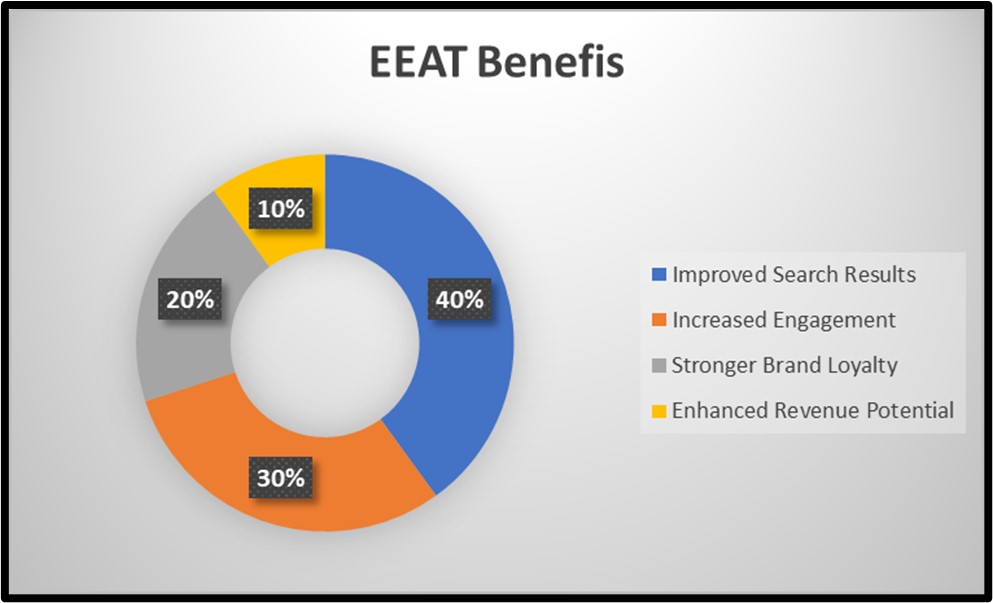
Building and Maintaining EEAT:
In the digital marketing niche, several websites showcase strong E-E-A-T across various aspects. Here are a few examples with specific strengths:
Strong E-A-T Examples in Digital Marketing Niche
| Website | Expertise | Authoritativeness | Trustworthiness | Experience |
| Moz (moz.com) | Leading SEO & marketing experts, in-depth articles, research reports | Industry thought leader contributions, awards, community forum | Transparent pricing, ethical marketing, data-driven insights | Runs annual conferences, hosts long-running MozBar tool, actively engages with community |
| Backlinko (backlinko.com) | Renowned SEO expert founder (Brian Dean), proven results | Cited by other websites, industry events participation | Detailed case studies, data-driven analysis, clear explanations | Brian Dean shares personal SEO experiments & learnings, years of industry experience |
| Search Engine Land (searchengineland.com) | Top SEO professionals & journalists, industry coverage | Widely recognized source, quoted by major publications | Strict editorial guidelines, balanced reporting, avoids clickbait | Covers industry news & trends for years, journalists draw on their own experience |
| Ahrefs (ahrefs.com) | Industry-leading SEO tools & resources, experienced team | In-depth guides, webinars, expert insights, data-driven analysis | Data accuracy, transparent pricing, ethical SEO practices | Offers free tools & resources, actively analyzes industry changes based on data & experience |
| Neil Patel (neilpatel.com) | Renowned digital marketing influencer, extensive experience | High website traffic, industry expert contributions | Actionable strategies, transparent advice (occasional self-promotion) | Shares personal marketing campaigns & results, years of consulting experience with various brands |
Resources & Tools to Evaluate and Improve Your Online EEAT
- Evaluating and improving EEAT is an ongoing process.
- No single tool or metric can definitively measure EEAT.
- Focus on delivering high-quality content, building trust with your audience, and adhering to ethical practices.
| Resource/Tool | Purpose | Metrics Assessed |
| Google Search Console: https://search.google.com/search-console/about | Tracks website performance and search visibility. | Organic traffic, clicks, impressions, keyword rankings, core web vitals, mobile-friendliness. |
| Moz Domain Authority (DA): https://moz.com/domain-analysis | Estimates website authority based on backlinks. | Domain authority, linking domains, linking root domains. |
| Ahrefs Backlink Checker: https://ahrefs.com/backlink-checker | Analyzes website backlinks and their quality. | Backlink profile, referring domains, domain rating (DR), anchor text distribution. |
| Semrush Brand Monitoring: https://www.semrush.com/ | Tracks brand mentions and sentiment online. | Brand mentions, sentiment score, top-performing content, social media engagement. |
| Buzzsumo Content Analyzer: https://buzzsumo.com/ | Analyzes content performance and popularity. | Social shares, comments, backlinks, estimated reach. |
| Google Analytics: https://analytics.google.com/analytics/academy/course/6 | Tracks website traffic and user behavior. | User demographics, page views, bounce rate, conversion rates, sources of traffic. |
| GTmetrix: https://gtmetrix.com/ | Measures website performance and speed. | Page load time, YSlow score, Lighthouse score, image optimization, caching. |
| Schema.org Markup Validator: https://validator.schema.org/ | Checks for structured data implementation errors. | Structured data errors, rich snippet eligibility. |
| Google My Business: https://www.google.com/business/ | Manages online business presence and local SEO. | Business profile completeness, customer reviews, engagement with reviews. |
5. Case Studies and Real-World Examples:
High-EAT Examples Across Industries: Medical, Real Estate, Agriculture, High-Profile Individuals
Medical:
1) Websites:
- Mayo Clinic (mayoclinic.org): Years of experience in patient care, extensive research and publications, renowned medical experts, rigorous editorial process.
- National Institutes of Health (nih.gov): Decades of research and data collection, government-backed authority, expert panels review information, commitment to transparency.
2) Individuals:
- Dr. Ashish Jha: Extensive experience in public health and policy, leadership roles in healthcare organizations, frequent media appearances, data-driven analysis.
- Dr. Atul Gawande: Surgeon with years of experience, published author and thought leader, advocates for patient-centered care, shares personal insights in writing.
Real Estate:
1) Websites:
- National Association of Realtors (nar.realtor): Over a century of experience in real estate, established code of ethics, educational resources, diverse member network.
- Zillow (zillow.com): Years of data collection and analysis, market trends insights, user reviews and testimonials, platform used by millions.
2) Individuals:
- Barbara Corcoran (https://twitter.com/BarbaraCorcoran): Decades of experience in real estate investing and development, television appearances showcase expertise, shares business lessons based on personal experiences.
- Gary Keller: Years as a real estate agent and leader, founded Keller Williams Realty, motivational speaker, shares leadership and market insights from years of experience.
Agriculture:
1) Websites:
- U.S. Department of Agriculture (usda.gov): Decades of research and data collection, experienced scientists and experts, field studies and ongoing monitoring, information tailored to various stakeholders.
- National Sustainable Agriculture Information Service (attra.ncat.org): Years of promoting sustainable practices, diverse network of farmers and experts, case studies and resources based on practical experience.
2) Individuals:
- Raj Patel: Extensive research and writing on food systems, years of activism and engagement with farmers, shares personal experiences and critical analysis.
- Vandana Shiva: Decades of experience in environmental activism and sustainable agriculture, founded Navdanya organization, shares personal stories and calls for action based on experience.
High-Profile Individuals:
Entrepreneurs:
- Mark Zuckerberg ([invalid URL removed]): Years of experience building and leading Facebook (now Meta), personal involvement in product development, shares insights into tech industry and company culture.
- Satya Nadella ([invalid URL removed]): Extensive experience in technology and leadership, transformed Microsoft’s cloud strategy, shares leadership lessons and vision for the future.
Scientists:
- Jane Goodall (https://twitter.com/JaneGoodallInst): Decades of experience studying chimpanzees, founded conservation organization, shares personal stories and insights based on years of fieldwork.
- Neil deGrasse Tyson (https://twitter.com/neiltyson): Extensive experience in astrophysics, engaging science communicator, shares personal anecdotes and humor to explain complex concepts.
The Future of EEAT: Navigating the Evolving Search Landscape
EEAT in 2024 and Beyond:
Emphasis on User Experience:
- Google’s focus will shift beyond “content quality” to “user experience.” Websites that prioritize user engagement, accessibility, and overall satisfaction will have an edge.
- AI-Powered Analysis: Expect more sophisticated AI tools to analyze content depth, user interactions, and author background, providing deeper insights into EEAT.
- Evolving Search Landscape: Google’s Search Generative Experience is just the beginning. Expect new search features and interfaces that challenge traditional content formats and elevate user-centricity.
Staying Informed and Adapting Strategies:
- Embrace Multifaceted Metrics: Move beyond traditional SEO metrics like backlinks and focus on user engagement, time spent on site, and click-through rates to gauge EAT effectively.
- Invest in User Experience: Prioritize website design, mobile-friendliness, and intuitive navigation to enhance user experience and search ranking potential.
- Become a Thought Leader: Share unique insights, engage in industry discussions, and build a reputation as a credible source to establish authoritativeness and expertise.
- Leverage AI Tools: Utilize AI-powered content analysis tools to identify areas for improvement and stay ahead of evolving EAT evaluation methods.
- Maintain Transparency and Trust: Be transparent about your expertise, sources, and funding. Prioritize data accuracy and ethical practices to build user trust.
Predictions:
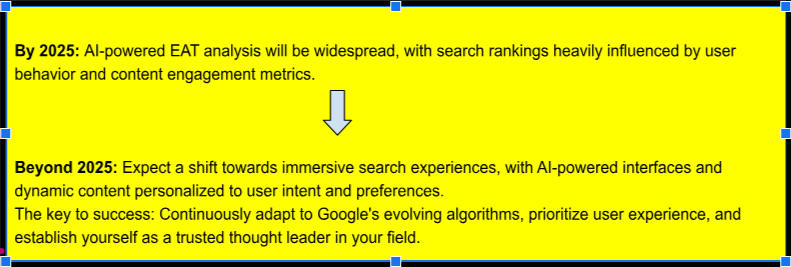
Conclusion
In conclusion, E-E-A-T (Experience, Expertise, Authoritativeness, and Trustworthiness) plays a crucial role in elevating your online presence and establishing credibility with both users and search engines. By understanding and implementing strategies to demonstrate expertise, authority, and trustworthiness, you can enhance your visibility, attract more organic traffic, and build long-lasting relationships with your audience. Prioritize E- E-A-T principles in your digital marketing efforts, and watch your online presence flourish.
As Google morphs and user needs shift, EEAT transforms from a static target to a dynamic dance. Navigate this by embracing user-centricity, thinking beyond content creation, establishing thought leadership, and continually adapting. Prioritize intuitive design, transparency, and ethical practices. Remember, the future of EEAT favors those who adapt, innovate, and prioritize user experience. Let’s dance together!
Also Read: Convert 70% visitors to leads with SEO Outreach for B2B and B2C – Ennoble Technologies
10 Principles for Website Renovation: Key Considerations for Revitalizing Your Online Presence
Having a website has now become a necessity. It is one of the easy-to-access and powerful leverages that could be used to achieve higher market goals and cut yourself from the competition. Your website shows your online presence, and it’s often where customers first connect with a business or individuals. Whether you own a small business or make a living as a blogger, you must ensure your website is up-to-date and user-friendly. In this article, we’ll discuss 10 principles for website renovation that are key considerations for revitalizing your online presence.
10 Principles to Consider for Website Renovation
A website is certainly a powerful and essential tool that showcases your products, services, or content. However, if it is slow, old, and not friendly, you could lose many potential customers or audiences.
Set Goals
Being specific about your goals helps you define what you want to achieve. It can be related to your website’s design, functionality, user experience, or business objectives. Some examples of rebuilding your website include increasing website traffic, sales, or leads. In addition, they include improving the engagement of users, making it more accessible, or updating website content.
Know Your Audience
You need to know who your majority audience is to understand their needs or expectations. Your website should be designed keeping your target audience in mind to ensure it is engaging, user-friendly, and provides what they need. For example, use vibrant colors and modern design elements if you are targeting young adults.
Create a Responsive Website
Responsive websites adjust to different screen sizes, such as desktops, tablets, and smartphones. Having a responsive website is essential because most people use the internet on mobile devices. And if yours doesn’t fit properly on the users’ screen, it can create problems accessing and reading the content.
Focus on User Experience
User experience (UX) determines whether visitors stay or leave. A website with good UX is easy to use, appears attractive, and doesn’t irritate users. There are various methods, including improving website navigation, using clear and concise language, creating a good menu bar, focusing on relevant images, etc. It would make the platform easy to use and understand.
Conduct a Content Audit
By auditing your content, you can check if it is outdated or irrelevant, and update or remove it. In addition, it helps identify gaps so you can create relevant content accordingly. You can seek help from tools such as Google Analytics to do a content audit. You can check how engaging they are and decide whether they need updating or removing.
Add social media
Social media integration allows visitors to connect with you and share your content on social platforms. However, increasing social signals also improve your website’s SEO. Adding social media icons or embedding social media feeds are some of the best ways to do so. You may include your social profiles in the header or footer to let visitors follow the brand on those platforms.
Optimize for Search Engines
Search engine optimization (SEO) increases website visibility in search engine results pages (SERPs). This is the ultimate way to drive more organic traffic. Some ways are proper keyword research, on-page optimization, link building, and more. It will help you rank well in search engines.
Ensure Security
A powerful security system protects your website and visitors’ personal information from cyberattacks. Eventually, you will be able to build trust and credibility. Some effective practices are using strong passwords, updating software and plugins, implementing HTTPS, and using a web application firewall (WAF).
Improve Site Speed
Site speed affects both user experience and SEO. A slow website can frustrate visitors and increase bounce rates, negatively impacting SEO. To improve site speed, optimize images and code, leverage browser caching, use a content delivery network (CDN), and more.
Check Results and Change the Strategy
Measuring your results will help you know whether your strategy is working. It allows you to make new changes and decisions. Instead of just blindly following, you would be able to identify new growth opportunities. It involves tracking website metrics, analyzing user behavior, and making decisions based on those data.
Conclusion
Renovating your website will improve its design, functionality, and user experience, making it more engaging and accessible to your audience. By following these 10 principles, you can revitalize your online presence and improve your website’s user experience, SEO, security, and performance. In spite of this, you should always monitor your results and make further plans as necessary.
Also Read: Emerging Trends in Voice Search Optimization for Digital Marketers – Ennoble Technologies

